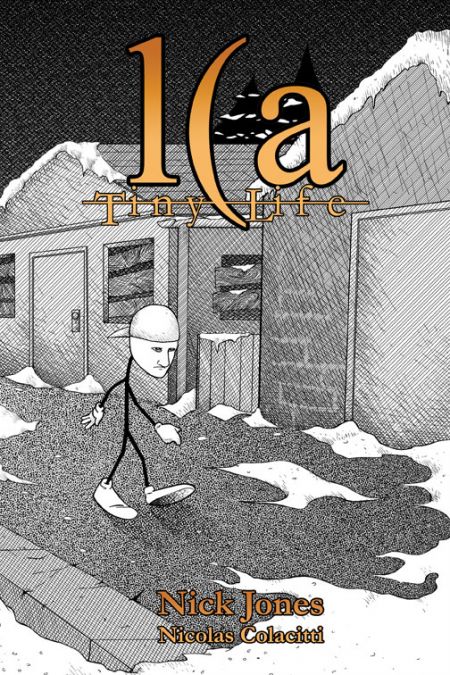Comics /
Comic Reviews /
More Comics
Tiny Life
By Hervé St-Louis
December 10, 2008 - 23:16
Jed Jr. is a weird young man. He’s a stick character rejected by his foster family after committing something awful. On his own, he decides to go back to his old home and find some of his old friends and family. Through his journey, he meets people who knew about his parents and finds out something that may change his life and how he perceives his heritage.
Occasionally, you read a comic book that offers many intriguing perspective that will require a second and perhaps a third reading. To read
1 (a – Tiny Life (pronounced el-ay, I suggest putting on some Léo Ferré album in the background. It’s not that the graphic novel’s mood fits some of the melancholic and heart throbbing songs of the late French poet and compositor. It’s mostly due to the many of the books’ words which echo some famous songs by Ferré.
One constant theme in Tiny Life is solitude and nothing reinforces that as much as the lonely and nude figure of a stick character caught in a world of plump and fleshy people. One of Ferré’s songs was about solitude and listening to it too often could make any sane person throw itself out a window. It’s just that depressing. I get the same feeling with Tiny Life. Reading it one too many times will depress me.
This leads to the theme of sanity which is covered in depth in this comic book. It’s all about how well one’s mind function and can place things, like memories or revelations into place. Jumble them up and you have insanity. It seems a bit strange to arrive at such crude definition of sanity and insanity, but it’s a fine balance that Jones shows constantly in this book.
Something else that Jones borrowed from Ferré without possibly knowing he did was the line about everything fades with time. Ferré’s best-known song was called, Avec le temps (Given Time). He keeps repeating, in the song that given time everything fades away. Jones’ characters repeat the same words too. Things that once bothered one made them either forget or drove them insane.
Tiny Life is mostly a post structuralist comic book. The actual course of action matters less than the intricate relationships of the various characters and elements of the story. Order matters not, although Jed, the main character seems to struggle in this world. As a stick character, he’s a line, a line that connects two ends – he’s a determinist in a post structural world that cares little for order and causality. Yet, his wandering mind, the omniscient narrator, is the most post structuralist of all.
This deterministic character in the middle of a post modern comic book is interesting but shows some of the weaknesses of the writer. These weaknesses are not the lack of talent, but the fear of not being understood, the isolation that the creator feels from his readers. In his quest to explain to readers why they should care about Tiny Life, Jones gives away the essential punch line and theme of his book in the forward that he wrote himself. He should have invited someone else to write it or create a fake name to put some perspective to his own graphic novel or even invite artist Nicolas Colacitti to write something.
There was no need to explain this book to his readers. I read it, skipping the introduction and the foreword. It’s not necessary. A more mature creator would have understood this and not felt fear or essential isolation from the world, the same the title character is going through. Tiny Life is not one of those navel-gazing autobiography. It’s really steeped in post modernism and thus apart from the attention to life’s detail and moronic tantrums that accompany many auto-biographical comic books.
Colacitti expresses the feelings his collaborator, Jones wishes, but it’s clear that he has had little say in how the story was crafted. He’s but an hired hand, good enough to comply with the complex vision of a writer trying to rewrite the great American graphic novel. His artwork is sometimes inconsistent, but he’s still capable of delivering the emotion and the isolated world of Jed. I may not find all of his panels illustrious, but he is a good storyteller.
The one aspect of this graphic novel that I must complain about is the lettering used the journals and letters. It’s a bad font and unreadable. It was too painful and contained so much information. Yet I skipped most of it because it just repelled me. The creators will have to think about using a better letter script font in future volumes. There’s no point asking readers to decipher a bad font with bad kerning and layout.
Rating: 8 /10
Last Updated: January 17, 2025 - 08:20

